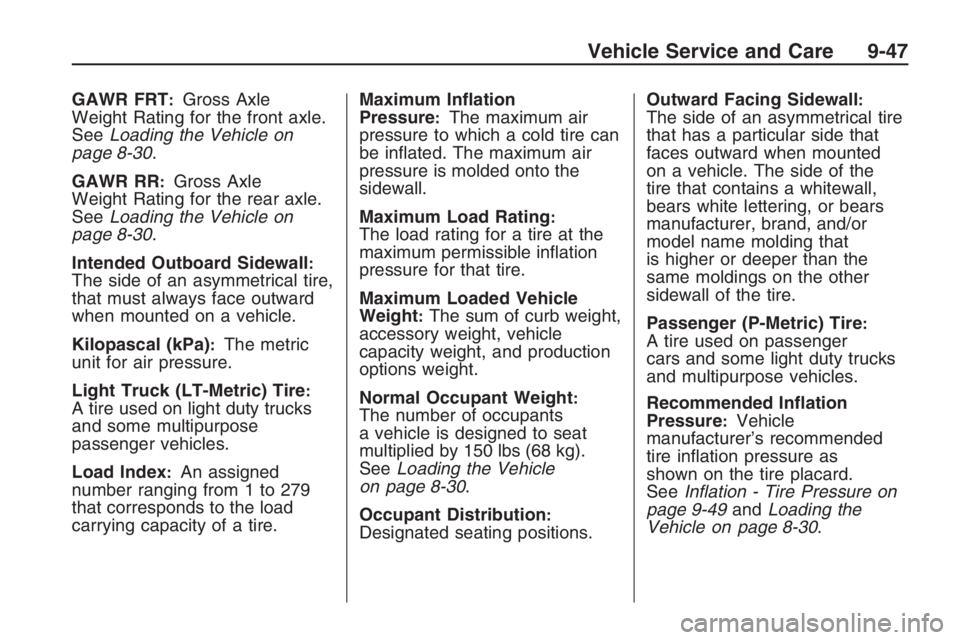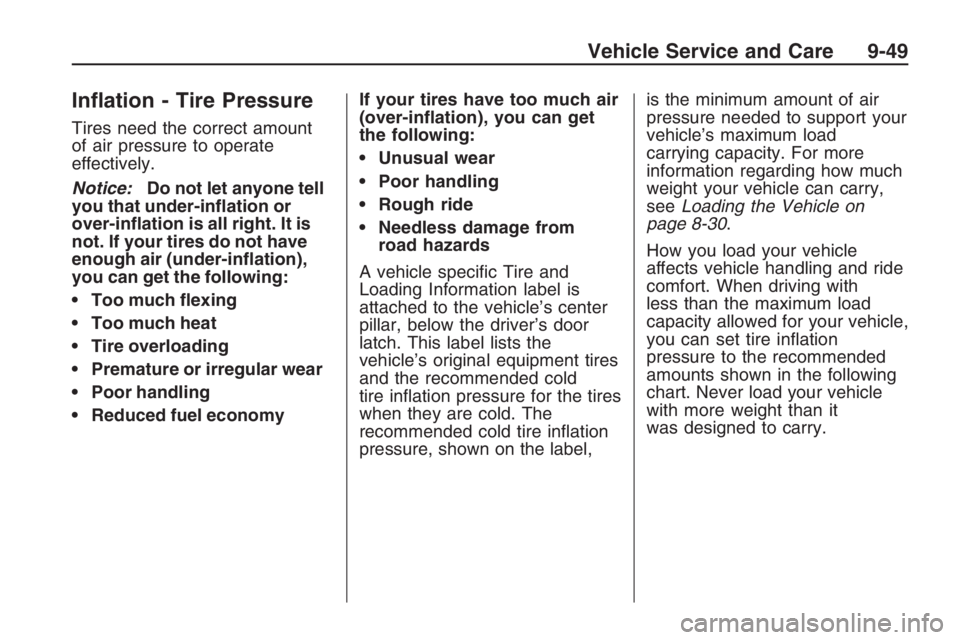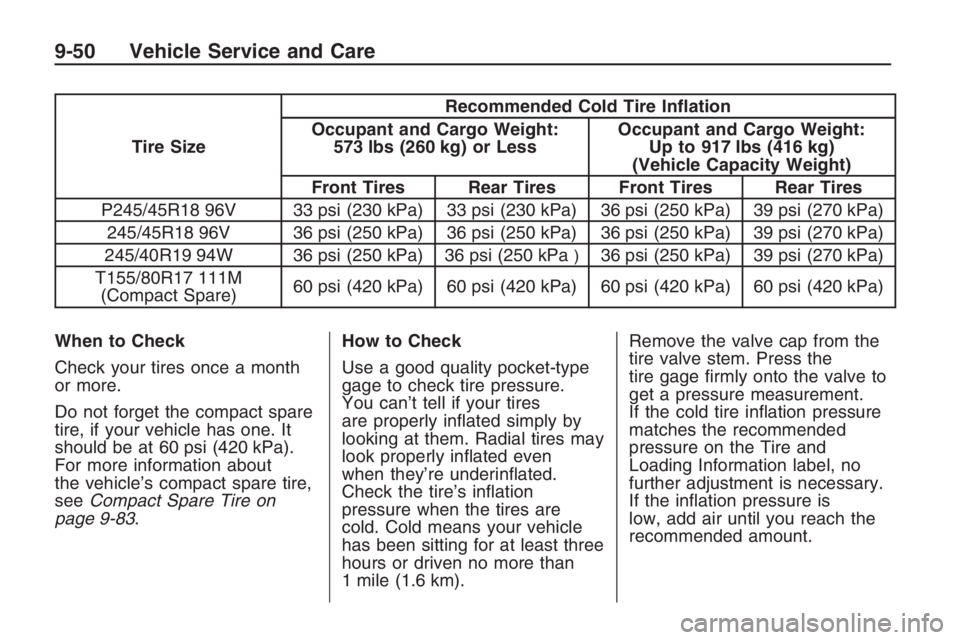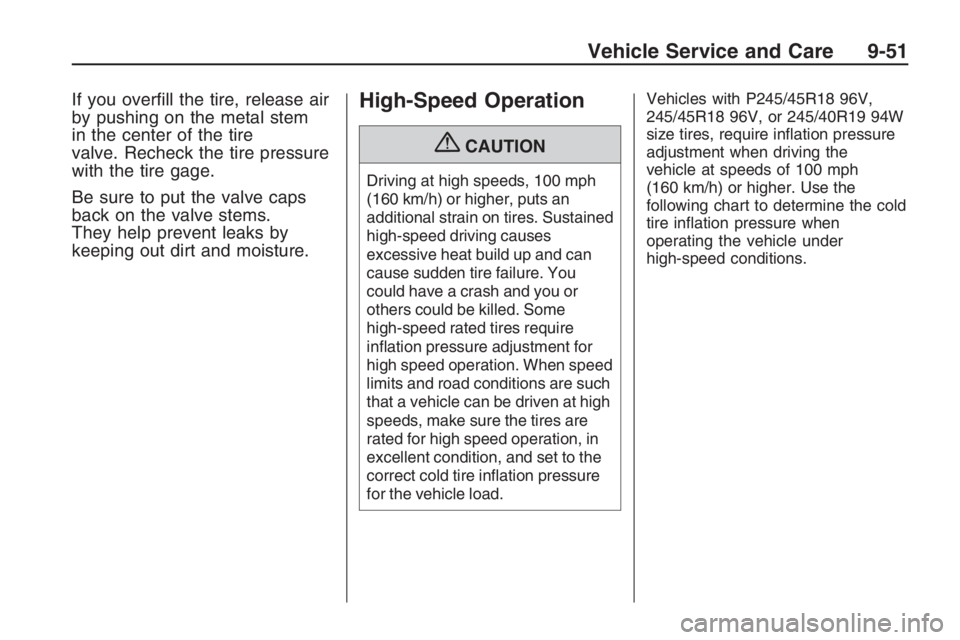2009 PONTIAC G8 service
[x] Cancel search: servicePage 248 of 356

(A) Temporary Use Only:The
compact spare tire or temporary
use tire has a tread life of
approximately 3,000 miles
(5 000 km) and should not be
driven at speeds over 65 mph
(105 km/h). The compact
spare tire is for emergency use
when a regular road tire has
lost air and gone �at. If your
vehicle has a compact spare tire.SeeCompact Spare Tire on
page 9-83andIf a Tire
Goes Flat on page 9-66.
(B) Tire Ply Material
:The type
of cord and number of plies
in the sidewall and under
the tread.
(C) Tire Identi�cation Number
(TIN)
:The letters and numbers
following the DOT (Department
of Transportation) code is
the Tire Identi�cation Number
(TIN). The TIN shows the
manufacturer and plant code,
tire size, and date the tire
was manufactured. The TIN is
molded onto both sides of
the tire, although only one side
may have the date of
manufacture.
(D) Maximum Cold In�ation
Load Limit
:Maximum load
that can be carried and
the maximum pressure needed
to support that load.(E) Tire In�ation
:The
temporary use tire or compact
spare tire should be in�ated
to 60 psi (420 kPa). For
more information on tire
pressure and in�ation see
Inflation - Tire Pressure on
page 9-49.
(F) Tire Size
:A combination of
letters and numbers de�ne a
tire’s width, height, aspect ratio,
construction type, and service
description. The letter T as
the �rst character in the tire size
means the tire is for temporary
use only.
(G) TPC Spec (Tire
Performance Criteria
Speci�cation)
:Original
equipment tires designed to
GM’s speci�c tire performance
criteria have a TPC speci�cation
code molded onto the sidewall.
GM’s TPC speci�cations meet
or exceed all federal safety
guidelines.
Compact Spare Tire Example
9-44 Vehicle Service and Care
Page 249 of 356

Tire Size
The following illustration shows
an example of a typical
passenger vehicle tire size.
(A) Passenger (P-Metric) Tire
:The United States version of
a metric tire sizing system.
The letter P as the �rst character
in the tire size means a
passenger vehicle tire
engineered to standards set
by the U.S. Tire and Rim
Association.(B) Tire Width
:The three-digit
number indicates the tire
section width in millimeters
from sidewall to sidewall.
(C) Aspect Ratio
:A two-digit
number that indicates the tire
height-to-width measurements.
For example, if the tire size
aspect ratio is 60, as shown in
item C of the illustration, it would
mean that the tire’s sidewall is
60 percent as high as it is wide.
(D) Construction Code
:A letter code is used to indicate
the type of ply construction in
the tire. The letter R means
radial ply construction; the
letter D means diagonal or bias
ply construction; and the
letter B means belted-bias ply
construction.(E) Rim Diameter
:Diameter of
the wheel in inches.
(F) Service Description
:These characters represent the
load range and speed rating
of the tire. The load index
represents the load carry
capacity a tire is certi�ed to
carry. The load index can range
from 1 to 279. The speed
rating is the maximum speed
a tire is certi�ed to carry
a load. Speed ratings range
fromAtoZ.
Vehicle Service and Care 9-45
Page 250 of 356

Tire Terminology and
De�nitions
Air Pressure:The amount of
air inside the tire pressing
outward on each square inch
of the tire. Air pressure is
expressed in pounds per square
inch (psi) or kilopascal (kPa).
Accessory Weight
:This
means the combined weight
of optional accessories.
Some examples of optional
accessories are, automatic
transmission, power steering,
power brakes, power windows,
power seats, and air
conditioning.
Aspect Ratio
:The relationship
of a tire’s height to its width.Belt
:A rubber coated layer of
cords that is located between the
plies and the tread. Cords may
be made from steel or other
reinforcing materials.
Bead
:The tire bead contains
steel wires wrapped by steel
cords that hold the tire onto
the rim.
Bias Ply Tire
:A pneumatic tire
in which the plies are laid at
alternate angles less than
90 degrees to the centerline of
the tread.
Cold Tire Pressure
:The
amount of air pressure in a tire,
measured in pounds per square
inch (psi) or kilopascals (kPa)
before a tire has built up heat
from driving. SeeInflation - Tire
Pressure on page 9-49.Curb Weight
:The weight of a
motor vehicle with standard
and optional equipment including
the maximum capacity of fuel,
oil, and coolant, but without
passengers and cargo.
DOT Markings
:A code molded
into the sidewall of a tire
signifying that the tire is in
compliance with the U.S.
Department of Transportation
(DOT) motor vehicle safety
standards. The DOT code
includes the Tire Identi�cation
Number (TIN), an alphanumeric
designator which can also
identify the tire manufacturer,
production plant, brand, and date
of production.
GVWR
:Gross Vehicle Weight
Rating. SeeLoading the Vehicle
on page 8-30.
9-46 Vehicle Service and Care
Page 251 of 356

GAWR FRT:Gross Axle
Weight Rating for the front axle.
SeeLoading the Vehicle on
page 8-30.
GAWR RR
:Gross Axle
Weight Rating for the rear axle.
SeeLoading the Vehicle on
page 8-30.
Intended Outboard Sidewall
:The side of an asymmetrical tire,
that must always face outward
when mounted on a vehicle.
Kilopascal (kPa)
:The metric
unit for air pressure.
Light Truck (LT-Metric) Tire
:A tire used on light duty trucks
and some multipurpose
passenger vehicles.
Load Index
:An assigned
number ranging from 1 to 279
that corresponds to the load
carrying capacity of a tire.Maximum In�ation
Pressure
:The maximum air
pressure to which a cold tire can
be in�ated. The maximum air
pressure is molded onto the
sidewall.
Maximum Load Rating
:The load rating for a tire at the
maximum permissible in�ation
pressure for that tire.
Maximum Loaded Vehicle
Weight
:The sum of curb weight,
accessory weight, vehicle
capacity weight, and production
options weight.
Normal Occupant Weight
:The number of occupants
a vehicle is designed to seat
multiplied by 150 lbs (68 kg).
SeeLoading the Vehicle
on page 8-30.
Occupant Distribution
:Designated seating positions.Outward Facing Sidewall
:The side of an asymmetrical tire
that has a particular side that
faces outward when mounted
on a vehicle. The side of the
tire that contains a whitewall,
bears white lettering, or bears
manufacturer, brand, and/or
model name molding that
is higher or deeper than the
same moldings on the other
sidewall of the tire.
Passenger (P-Metric) Tire
:A tire used on passenger
cars and some light duty trucks
and multipurpose vehicles.
Recommended In�ation
Pressure
:Vehicle
manufacturer’s recommended
tire in�ation pressure as
shown on the tire placard.
SeeInflation - Tire Pressure on
page 9-49andLoading the
Vehicle on page 8-30.
Vehicle Service and Care 9-47
Page 252 of 356

Radial Ply Tire:A pneumatic
tire in which the ply cords that
extend to the beads are laid
at 90 degrees to the centerline
of the tread.
Rim
:A metal support for a
tire and upon which the
tire beads are seated.
Sidewall
:The portion of a tire
between the tread and the bead.
Speed Rating
:An alphanumeric
code assigned to a tire
indicating the maximum speed
at which a tire can operate.
Traction
:The friction between
the tire and the road surface.
The amount of grip provided.
Tread
:The portion of a tire that
comes into contact with the road.Treadwear Indicators
:Narrow
bands, sometimes called
wear bars, that show across
the tread of a tire when only
1/16 inch (1.6 mm) of tread
remains. SeeWhen It Is Time
for New Tires on page 9-59.
UTQGS (Uniform Tire Quality
Grading Standards)
:A tire
information system that provides
consumers with ratings for a
tire’s traction, temperature,
and treadwear. Ratings are
determined by tire manufacturers
using government testing
procedures. The ratings are
molded into the sidewall of the
tire. SeeUniform Tire Quality
Grading on page 9-62.Vehicle Capacity Weight
:The number of designated
seating positions multiplied
by 150 lbs (68 kg) plus the rated
cargo load. SeeLoading the
Vehicle on page 8-30.
Vehicle Maximum Load on
the Tire
:Load on an individual
tire due to curb weight,
accessory weight, occupant
weight, and cargo weight.
Vehicle Placard
:A label
permanently attached to a
vehicle showing the vehicle’s
capacity weight and the original
equipment tire size and
recommended in�ation pressure.
See “Tire and Loading
Information Label” under
Loading the Vehicle on
page 8-30.
9-48 Vehicle Service and Care
Page 253 of 356

In�ation - Tire Pressure
Tires need the correct amount
of air pressure to operate
effectively.
Notice:Do not let anyone tell
you that under-in�ation or
over-in�ation is all right. It is
not. If your tires do not have
enough air (under-in�ation),
you can get the following:
Too much �exing
Too much heat
Tire overloading
Premature or irregular wear
Poor handling
Reduced fuel economyIf your tires have too much air
(over-in�ation), you can get
the following:
Unusual wear
Poor handling
Rough ride
Needless damage from
road hazards
A vehicle speci�c Tire and
Loading Information label is
attached to the vehicle’s center
pillar, below the driver’s door
latch. This label lists the
vehicle’s original equipment tires
and the recommended cold
tire in�ation pressure for the tires
when they are cold. The
recommended cold tire in�ation
pressure, shown on the label,is the minimum amount of air
pressure needed to support your
vehicle’s maximum load
carrying capacity. For more
information regarding how much
weight your vehicle can carry,
seeLoading the Vehicle on
page 8-30.
How you load your vehicle
affects vehicle handling and ride
comfort. When driving with
less than the maximum load
capacity allowed for your vehicle,
you can set tire in�ation
pressure to the recommended
amounts shown in the following
chart. Never load your vehicle
with more weight than it
was designed to carry.
Vehicle Service and Care 9-49
Page 254 of 356

Tire SizeRecommended Cold Tire In�ation
Occupant and Cargo Weight: 573 lbs (260 kg) or Less Occupant and Cargo Weight:
Up to 917 lbs (416 kg)
(Vehicle Capacity Weight)
Front Tires Rear Tires Front Tires Rear Tires
P245/45R18 96V 33 psi (230 kPa) 33 psi (230 kPa) 36 psi (250 kPa) 39 psi (270 kPa) 245/45R18 96V 36 psi (250 kPa) 36 psi (250 kPa) 36 psi (250 kPa) 39 psi (270 kPa)
245/40R19 94W 36 psi (250 kPa) 36 psi (250 kPa
)36 psi (250 kPa) 39 psi (270 kPa)
T155/80R17 111M (Compact Spare) 60 psi (420 kPa) 60 psi (420 kPa) 60 psi (420 kPa) 60 psi (420 kPa)
When to Check
Check your tires once a month
or more.
Do not forget the compact spare
tire, if your vehicle has one. It
should be at 60 psi (420 kPa).
For more information about
the vehicle’s compact spare tire,
see Compact Spare Tire on
page 9-83 . How to Check
Use a good quality pocket-type
gage to check tire pressure.
You can’t tell if your tires
are properly in�ated simply by
looking at them. Radial tires may
look properly in�ated even
when they’re underin�ated.
Check the tire’s in�ation
pressure when the tires are
cold. Cold means your vehicle
has been sitting for at least three
hours or driven no more than
1 mile (1.6 km). Remove the valve cap from the
tire valve stem. Press the
tire gage �rmly onto the valve to
get a pressure measurement.
If the cold tire in�ation pressure
matches the recommended
pressure on the Tire and
Loading Information label, no
further adjustment is necessary.
If the in�ation pressure is
low, add air until you reach the
recommended amount.
9-50 Vehicle Service and Care
Page 255 of 356

If you over�ll the tire, release air
by pushing on the metal stem
in the center of the tire
valve. Recheck the tire pressure
with the tire gage.
Be sure to put the valve caps
back on the valve stems.
They help prevent leaks by
keeping out dirt and moisture.High-Speed Operation
{CAUTION
Driving at high speeds, 100 mph
(160 km/h) or higher, puts an
additional strain on tires. Sustained
high-speed driving causes
excessive heat build up and can
cause sudden tire failure. You
could have a crash and you or
others could be killed. Some
high-speed rated tires require
in�ation pressure adjustment for
high speed operation. When speed
limits and road conditions are such
that a vehicle can be driven at high
speeds, make sure the tires are
rated for high speed operation, in
excellent condition, and set to the
correct cold tire in�ation pressure
for the vehicle load.Vehicles with P245/45R18 96V,
245/45R18 96V, or 245/40R19 94W
size tires, require in�ation pressure
adjustment when driving the
vehicle at speeds of 100 mph
(160 km/h) or higher. Use the
following chart to determine the cold
tire in�ation pressure when
operating the vehicle under
high-speed conditions.
Vehicle Service and Care 9-51